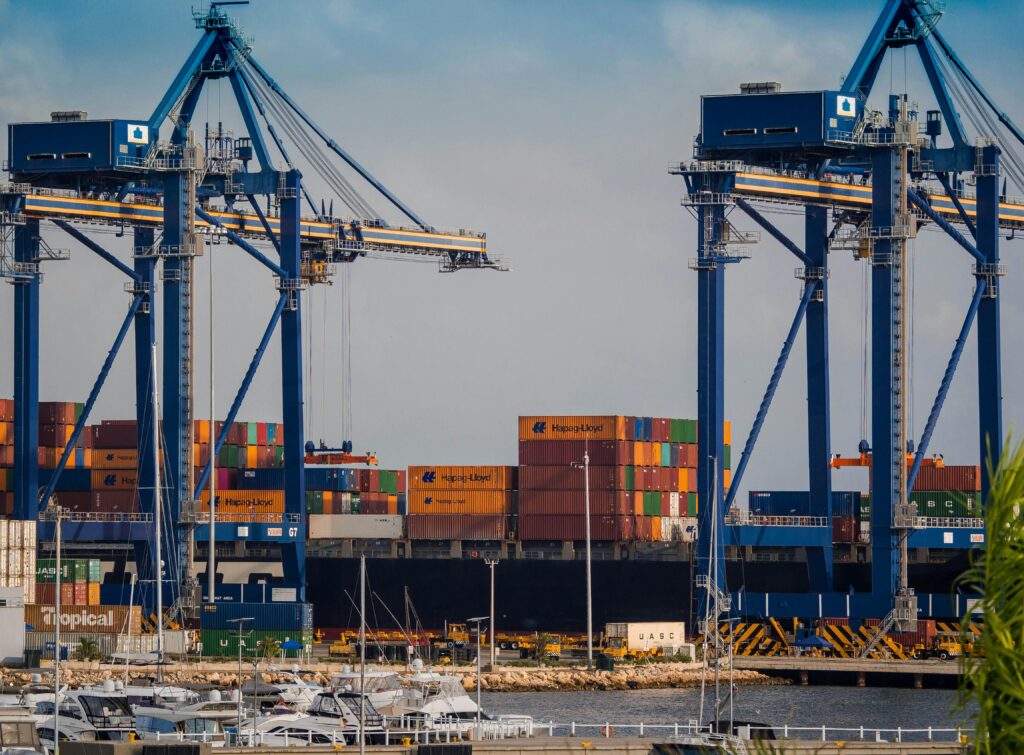
Multimodal Transport
The world is more connected than ever.
Today, efficiency in transport networks has become paramount. As the logistics industry evolves to meet growing demands, multimodal transport has emerged as a key solution. By integrating various modes like road, rail, sea, and air under a single contract, businesses can navigate the complexities of modern shipping needs with unprecedented cohesion and reliability.
Understanding the Concept of “Multimodal Transportation”
Multimodal transportation is an advanced logistics strategy that aims to enhance efficiency and reliability.
It involves using two or more different modes of transport, managed through a single contract. This contrasts with intermodal transport, where each segment requires separate agreements.
The primary advantage of multimodal transportation lies in its streamlined management. One service provider oversees the entire journey, ensuring a cohesive and coordinated operation.
This method optimizes resource utilization and fosters seamless transitions between transport modes. Consequently, businesses can benefit from reduced transit times and fewer logistical hiccups.
Embracing multimodal transport is more than a logistical choice; it’s a strategic commitment to superior supply chain management.
Different Modes of Transport Used in Multimodal Transportation
Multimodal transport inspires efficient logistics by integrating diverse transport options, such as road, rail, sea, air, and pipelines. Each mode offers unique strengths, enhancing the process through flexibility, bulk handling, cost-effectiveness, speed, and continuity in resource delivery.
1. Road Transport
Road transport is the backbone of logistics—integral to multimodal transport by bridging urban and rural areas seamlessly.
Road transport is pivotal in last-mile delivery, directly connecting origins to final destinations.
With unrivaled flexibility and accessibility, road transport handles an extensive variety of goods, making it indispensable within any transportation framework.
Moreover, its widespread network and the ability to adapt to unpredictable conditions ensure timely deliveries, fulfilling stringent deadlines and logistical demands.
2. Rail Transport
Rail transport shines as a vital component in the multimodal transport network, efficiently moving large volumes over extensive distances.
This mode of transport is particularly advantageous for bulk commodities such as coal, grain, and other raw materials, leveraging economies of scale to reduce transportation costs significantly. Additionally, rail transport’s energy efficiency results in lower environmental impacts, further solidifying its crucial role in sustainable logistics operations.
Equipped with the capacity for substantial loads, rail transport ensures a streamlined journey by minimizing congestion commonly experienced with road transport. The integration of rail within a multimodal system guarantees that shipments remain cost-effective and efficient while spanning vast terrains.
By incorporating rail transport into a multimodal strategy, businesses unlock the potential for more predictable schedules and improved safety for goods in transit. This reliability, coupled with fewer emissions, highlights rail transport as a forward-thinking choice for long-distance shipping and the overarching goal of optimized logistics solutions.
3. Sea Transport
Maritime transport is a cornerstone of international trade, connecting continents, and facilitating a vast array of global economic activities. This mode of transport is particularly favored for its efficiency in handling large, bulky shipments that would be impractical or costly to move via other means.
By utilizing large cargo vessels, sea transport can carry enormous amounts of goods across the world’s oceans. This capability makes it indispensable for industries that rely on the bulk movement of raw materials, manufactured products, and even specialized freight.
Despite its inherent efficiency and capacity advantages, sea transport does come with some limitations. One of the primary drawbacks is the relatively slower transit times compared to air transport, which can be a concern for time-sensitive deliveries.
However, the cost-effectiveness of sea transport cannot be overstated. For bulk goods, there is no more economical way to cover vast distances while maintaining a lower cost per unit. This makes it ideal for shipping goods where speed is less critical.
Ports around the world serve as vital hubs for the loading and unloading of cargo, facilitating seamless transitions to other modes of transport in a multimodal system. The coordination of these activities ensures that goods are moved through supply chains efficiently and reach their final destinations intact.
Overall, the role of sea transport in multimodal logistics is indispensable, offering a balance of cost-efficiency and capacity. It sustains global commerce by providing a reliable backbone for the movement of goods across the globe.
4. Air Transport
Air transport is an indispensable element of multimodal transport, offering unparalleled speed for urgent shipments. When time is of the essence, air transport excels in meeting critical delivery deadlines.
This mode revolutionizes logistics with its ability to cover vast distances swiftly.
Notably, air transport is the preferred option for perishable goods, such as fresh produce and pharmaceuticals.
Its speed provides a significant advantage in minimizing spoilage and maintaining product quality.
While air transport’s cost is generally higher, the benefits of timely deliveries can outweigh the expenses. Companies often employ this mode for high-value goods requiring rapid transit.
Thus, the inclusion of air transport in a multimodal system ensures flexibility and enhances overall supply chain effectiveness.
5. Pipeline Transport
Pipeline transport is indispensable for moving liquids and gases over extensive distances with minimal disruption.
- Oil and Gas: Transporting crude oil, natural gas, and petroleum products.
- Chemical Products: Moving chemical fuels and biofuels.
- Lower Emissions: Offers an environmentally friendly alternative to road transport.
- Cost-Efficiency: Reduces transportation costs by providing a steady flow of resources.
- Safety: Mitigates risks associated with road and rail transport of hazardous materials.
Pipelines operate continuously, ensuring a regular and uninterrupted supply of energy resources.
While primarily used in the energy sector, pipelines showcase their potential in fostering a sustainable logistics ecosystem.
Pipelines are not the only effective method in the logistics chain. Freight plays a crucial role in transporting goods across long distances efficiently, whether by rail, road, or sea. The integration of freight services with other transport methods enhances the reliability and scalability of the logistics network, ensuring a robust supply chain.
Intermodal transportation, which involves the use of multiple modes of transportation such as rail, road, and sea within a single journey, is essential for modern logistics. It allows for greater flexibility and efficiency by optimizing the strengths of different transport methods. This approach not only enhances the capacity of the logistics network but also improves the resilience of the supply chain by providing alternative routes and options, reducing the risk of disruptions.
Benefits of Using Multiple Transport Methods
Embracing multiple transport methods enhances operational efficiency, adaptability, and reliability in the logistics industry, providing a comprehensive transportation solution that caters to diverse shipping demands.
Clear communication between service providers ensures that crucial information flows seamlessly across all stages of the transportation process, making the most of existing infrastructure.
This not only expedites the movement of goods but also minimizes delays.
Timely deliveries help businesses build a reputation for reliability and foster customer trust.
By leveraging various transport modes, companies can access even the most remote areas, ensuring their products reach every customer.
Intermodal shipping, which involves using multiple forms of transportation such as rail, truck, and ship for a single shipment, plays a vital role in optimizing the logistics process. This method enhances flexibility and efficiency by allowing companies to select the most cost-effective and time-efficient transport combinations for their needs. Intermodal shipping not only reduces dependency on any single mode of transport but also mitigates risks associated with delays and disruptions in the supply chain.
A multimodal transport operator plays a crucial role in coordinating various transportation methods to ensure the seamless movement of goods. By managing the complexities associated with integrating rail, road, sea, and air transport, these operators provide a streamlined approach to logistics. They effectively handle the entire transportation chain under a single contract, which simplifies the process for businesses and reduces potential delays or inefficiencies. Utilizing a multimodal transport operator can lead to significant cost savings, enhanced reliability, and improved customer satisfaction as businesses can rely on a single point of contact for all their shipping needs.
Moreover, with a single contract governing the entire journey, responsibility is clear and straightforward, leading to smoother issue resolution.
Challenges of Using Multiple Transport Methods
Managing multimodal transport can lead to increased complexity, especially regarding the administrative effort and documentation involved.
Oversight of multiple modes of transport often necessitates the handling of different billing documents, insurance requirements, and regulatory compliance issues. To manage these effectively, businesses must leverage digital tools and integrated logistics platforms to streamline processes and reduce potential bureaucratic bottlenecks.
Advanced tracking systems are crucial to overcoming these challenges, ensuring real-time shipment visibility and mitigating disruptions in the supply chain.
1. More Paperwork
When managing multimodal transport, businesses often grapple with the extensive paperwork necessary to coordinate various logistics.
Each transport mode requires its own set of documentation, including billing and insurance documents, and compliance with distinct regulatory requirements. This paperwork can quickly become overwhelming, causing significant administrative strain and potential delays in the shipping process.
Consequently, companies must invest in sophisticated digital tools to manage this complexity effectively. Utilizing integrated logistics platforms can help automate many of the tasks associated with document handling, reducing the administrative burden and speeding up processes.
In turn, adopting best practices in document management is essential for maintaining efficiency while minimizing risk. By prioritizing organized paperwork through technology, businesses can ensure smoother operations, enhanced tracking of shipments, and better overall performance of their multimodal transport systems.
2. Difficulty Tracking Shipments
In the dynamic world of multimodal transport, tracking shipments accurately is imperative for operational efficiency.
Since 2016, advancements in tracking technology, such as Internet of Things (IoT) devices, have significantly improved visibility across various transport modes, helping companies enhance their logistic strategies.
However, it’s still quite common to encounter gaps in visibility due to the distinct nature of each transport segment and the varying technological capabilities of different transportation providers.
Transferring goods from one mode to another introduces complexities, which can lead to breaks in the tracking chain. For example, while rail might have a robust tracking system, maritime and road segments might rely on older technology, reducing real-time visibility.
Consequently, integrating advanced technologies can bridge these gaps, offering consistent, real-time tracking and elevating the overall efficacy of the multimodal transport network.
3. Disruptions in the Supply Chain
Different transport methods can lead to disruptions if one method is delayed.
This can affect the entire delivery process heavily.
To prepare for this, businesses should have contingency plans. They must maintain good communication with everyone involved, including transport carriers, logistics providers, and customers.
By proactively anticipating potential bottlenecks and developing strategic responses, companies can minimize disruptions and maintain supply chain continuity. Investing in risk management and predictive analytics tools can further enhance their ability to swiftly address unforeseen challenges, ensuring reliable and efficient multimodal transportation.
Tips for Successful Multimodal Transportation
Planning ahead is the cornerstone of successful multimodal transportation. Businesses should meticulously map out routes, establish precise schedules, and develop robust backup plans. By embracing these strategies, companies can ensure seamless transitions across various transport modes, minimizing disruptions and enhancing overall efficiency.
Additionally, leveraging technology is imperative. Advanced tracking systems and integrated communication platforms facilitate real-time updates, improving coordination and transparency. Building strong relationships with reliable transport carriers further guarantees smooth transitions and adherence to schedules. Understanding the regulations governing each transport mode is equally crucial, as it helps avoid compliance issues and fosters a smoother shipping experience.
1.Plan Ahead
Effective planning is essential for seamless multimodal transportation. Proper preparation can significantly prevent potential disruptions and ensure timely deliveries.
- Map Out Routes: Choose the best routes for efficiency.
- Develop Schedules: Create detailed schedules to synchronize different modes of transport.
- Backup Plans: Always have contingency plans ready in case of unforeseen issues.
By thoroughly planning routes, schedules, and backup options, businesses can preemptively tackle many common obstacles.
Further, detailed planning helps in mitigating risks and achieving reliable and efficient multimodal transport operations.
Freight plays a pivotal role in the success of multimodal transport operations. Effective freight management ensures that goods are moved efficiently through various transportation modes, thereby optimizing the supply chain. Proper handling and coordination of freight can significantly reduce transit times, lower costs, and improve overall service quality, making it an essential aspect of logistics planning.
Intermodal transportation enhances the efficiency and flexibility of logistics operations by combining different transportation modes in a seamless network, leveraging existing infrastructure to optimize performance. This approach enables businesses to use the most effective mode for each segment of the journey, thereby optimizing transit times and reducing costs. Intermodal transportation also encourages a more sustainable logistics practice by allowing the strategic use of environmentally friendly options such as rail and sea freight. As a result, companies can better manage their resources, improve customer satisfaction, and adapt to changes in the supply chain environment.
A multimodal transport
operator is instrumental in ensuring the seamless coordination and integration of various transportation modes. By managing the complex logistics involved in intermodal shipping, these operators enhance the efficiency and reliability of supply chains. They oversee the entire process, from planning and scheduling to execution and monitoring, ensuring that each transition between transport modes is smooth and efficient. Their expertise in handling complex operations significantly contributes to optimizing transit times, minimizing costs, and maintaining high service levels in multimodal transport operations.
Intermodal shipping plays a crucial role in optimizing multimodal transport operations. This approach involves using multiple modes of transportation, such as ship, truck, and rail, to move goods from origin to destination efficiently. By leveraging the strengths of each mode, businesses can reduce transit times, minimize costs, and lower environmental impact. Additionally, intermodal shipping allows for greater flexibility and adaptability in logistics planning, ensuring that shipments can be rerouted or adjusted seamlessly in response to unforeseen disruptions.
2. Stay Flexible
Adaptability helps maintain operational consistencyBeing able to pivot quickly can save valuable time. The logistics industry is rife with sudden changes and unexpected disruptions. Preparedness for such contingencies demonstrates resilience and can ensure deliveries remain on track. Flexibility allows businesses to adjust to unforeseen challenges without incurring significant delays or financial losses.
Always consider possible alternative routes.
Flexibility often means modifying plans on the fly—if one mode of transport faces an issue, a switch to another mode might be necessary. This could mean rerouting shipments or employing different carriers at short notice.
Flexibility fosters a culture of swift problem resolution and innovation. For instance, during peak seasons in 2023, multimodal transport providers who embraced flexibility navigated through congestion and ensured timely deliveries. Cultivating an agile approach will become increasingly beneficial as global supply chains grow more complex and customer expectations evolve.
3. Use Technology:
Technology is crucial for successful multimodal transport.
Advanced tracking systems are essential in this modern age. These tools allow businesses to monitor their shipments in real-time, providing critical data on the location and condition of goods in transit. Consequently, staying up to date on the progress of shipments not only enhances operational efficiency but also boosts customer confidence.
Digital platforms streamline logistics processes.
Companies see reduced paperwork loads—billing, insurance, and documentation can all be managed digitally on integrated logistics platforms. These platforms support seamless communication between various stakeholders, minimizing errors and ensuring that each transition between transport modes is smooth and efficient.
By harnessing innovative technology solutions like automated route planning and predictive analytics, firms can anticipate potential delays or disruptions, adjusting plans proactively. This level of responsiveness ultimately leads to greater punctuality, fewer disruptions, and increased customer satisfaction in multimodal transport operations.
4. Build Strong Relationships
Building strong relationships with transport carriers is essential for ensuring seamless transitions between different modes of transport.
- Communication: Maintain open lines for clear instructions and updates.
- Trust: Develop mutual trust through consistent reliability and transparency.
- Partnership: Forge long-term partnerships for enhanced collaboration.
- Feedback: Regularly exchange feedback to improve processes.
- Commitment: Show commitment by honoring agreements and deadlines.
These elements will help cultivate strong, professional relationships essential for smooth multimodal operations.
A solid partnership can lead to improved efficiency and fewer disruptions.
Investing in relationships with carriers can yield long-term benefits and increased customer satisfaction.
5. Know the Rules
Understanding the regulations for each transportation mode is crucial to avoid compliance issues and ensure smooth operations.
- Regulations Compliance: Each mode of transport has specific regulations that must be adhered to.
- Customs Documentation: Ensure all customs paperwork is accurate and complete for international shipments.
- Safety Standards: Follow safety standards to prevent accidents and liabilities.
- Environmental Norms: Adhere to environmental guidelines to minimize ecological impact.
- Insurance Requirements: Meet all insurance requirements to cover potential risks.
Adequate knowledge of these rules safeguards against legal complications and delays.
Compliance with various regulations helps maintain the integrity and timeliness of the supply chain.
Conclusion
Multimodal transport is revolutionizing the logistics industry by offering flexibility and efficiency in goods movement.
It combines various modes of transportation, such as road, rail, sea, and air, under a single contract.
This unified approach simplifies logistics management and enhances accountability, ensuring smoother operations from origin to destination.
The strategic integration of different transport methods minimizes delays, reduces environmental impact, and provides cost-effective solutions for businesses.
In an ever-evolving market, embracing multimodal transport is paramount for success in global trade.


